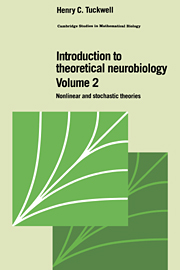8 - Theory of the action potential
Published online by Cambridge University Press: 27 January 2010
Summary
Introduction
In Chapter 1 we saw that sufficient depolarization of a motoneuron, due either to current injection or excitatory synaptic input, could cause the occurrence of an action potential. During the action potential the polarity of the cell membrane was briefly reversed, the inside of the cell becoming temporarily at a positive electrical potential relative to the outside. Furthermore, this depolarizing pulse propagated along the axon of the cell to eventually reach the target muscle cells that were excited at the neuromuscular synapses. The reader should also review the first experimental recording of the action potential, that for the squid giant axon shown in Figure 2.1.
In this chapter a theory of the action potential will be presented. This theory relies almost solely on the works of the great trio of physiologists, Hodgkin, Huxley, and Katz. Not only did they perform the many key experiments but they also developed cogent mathematical models in the form of systems of differential equations — the Hodgkin—Huxley equations. These equations have given considerable impetus to the mathematical study of nonlinear partial differential equations. The equations cannot be solved in the sense that solutions of the linear (Chapters 5 and 6) and bilinear (Chapter 7) cable equations could be found.
- Type
- Chapter
- Information
- Introduction to Theoretical Neurobiology , pp. 40 - 110Publisher: Cambridge University PressPrint publication year: 1988



